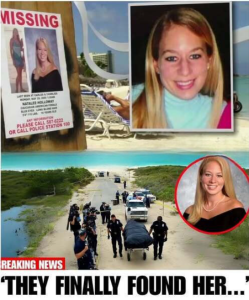“The Last Sunset: Natalee Holloway’s Final Hours and the Long Road to Truth”
For two decades, the name Natalee Holloway echoed through headlines, courtrooms, and the hearts of millions. Her disappearance in Aruba in May 2005 became one of the most haunting mysteries of the 21st century—a story of innocence lost, justice delayed, and a mother’s relentless pursuit of answers. Now, twenty years later, the veil has lifted. The truth is not just heartbreaking—it’s devastating.
Natalee was 18, radiant with promise, and celebrating her high school graduation with classmates on the sun-drenched beaches of Aruba. On the night of May 30th, she was last seen leaving a nightclub with Joran van der Sloot, a Dutch teenager whose name would become synonymous with suspicion and deceit. Despite exhaustive searches and international media coverage, Natalee was never found. Her story became a symbol of unresolved grief and the cruel silence of unanswered questions.
But in 2025, the silence broke.
In a chilling confession obtained as part of a plea deal in a separate extortion case, Joran van der Sloot finally admitted what many had long suspected: he had murdered Natalee Holloway. The details, revealed in court documents and interviews, were more brutal than anyone had imagined.
According to van der Sloot, he and Natalee walked along the beach that night. He claimed they kissed, but when he tried to escalate the encounter, Natalee resisted. She told him “no.” She kneed him in the groin when he refused to stop. Enraged, van der Sloot kicked her in the face, rendering her unconscious. Then, in a moment of horrifying violence, he picked up a nearby cinder block and smashed her head in. “Her face basically collapsed in,” he said, describing the act with a disturbing lack of remorse.
The confession was not just a legal milestone—it was an emotional earthquake. For Beth Holloway, Natalee’s mother, who had spent twenty years chasing shadows and confronting lies, the revelation was both a vindication and a fresh wound. She had always believed van der Sloot was responsible. Now, she had the words from his own mouth. But the horror of those words was almost too much to bear.
“I lay her down – we lay down together – in the sand and, uh, we start kissing each other,” van der Sloot said in the recorded confession. “She tells me ‘no.’ She tells me she doesn’t want me to — to feel her up. Uh, I insist. I keep feeling her up either way.” When Natalee resisted, he responded with violence. “I take this and uh, yeah, I– I– I smash her head in with it completely,” he said.
The confession came as part of a plea agreement in a federal case in Alabama, where van der Sloot had been charged with extortion for attempting to sell false information about Natalee’s remains to her mother. Ironically, it was this act of manipulation that ultimately led to the truth. In exchange for a reduced sentence, van der Sloot agreed to tell the full story of what happened that night.
But even with the confession, justice remains elusive. Aruba’s statute of limitations prevents prosecution for the murder, meaning van der Sloot may never face legal consequences for Natalee’s death. He remains imprisoned in Peru for the 2010 murder of Stephany Flores, another young woman whose life he brutally ended.
The parallels between the two cases are chilling. Both women were young, vibrant, and trusting. Both encountered van der Sloot in moments of celebration. And both were silenced by his violence. The confession not only confirmed Natalee’s fate—it painted van der Sloot as a predator whose crimes spanned continents and years.
For the Holloway family, the confession brought a complex mix of emotions. Relief, rage, sorrow, and a renewed sense of purpose. Beth Holloway, who had become an advocate for missing persons and victims’ families, stood in court and confronted her daughter’s killer. “You brutally killed her,” she said, her voice steady but filled with pain.
The world, too, reacted with shock and sadness. For years, Natalee’s story had been a cautionary tale, a mystery that refused to fade. Now, it was a tragedy with a name, a face, and a final chapter. But closure, if it exists, is not simple. The truth may be known, but the loss remains.
In the wake of the confession, renewed calls for reform echoed across legal and political circles. Advocates urged changes to international statutes of limitations, arguing that justice should not expire with time. Others called for greater protections for travelers and stronger cooperation between nations in cases of missing persons.
Natalee’s story, now complete, continues to inspire. Her memory lives on in foundations, scholarships, and the hearts of those who followed her case. Her mother’s courage, her classmates’ loyalty, and the global community’s empathy have turned tragedy into a legacy of advocacy and awareness.
Twenty years later, the truth has emerged. It is more devastating than anyone imagined. But it is also a testament to the power of persistence, the importance of truth, and the enduring strength of love.
Natalee Holloway was more than a headline. She was a daughter, a friend, a dreamer. And now, finally, she is not just missing—she is remembered.


